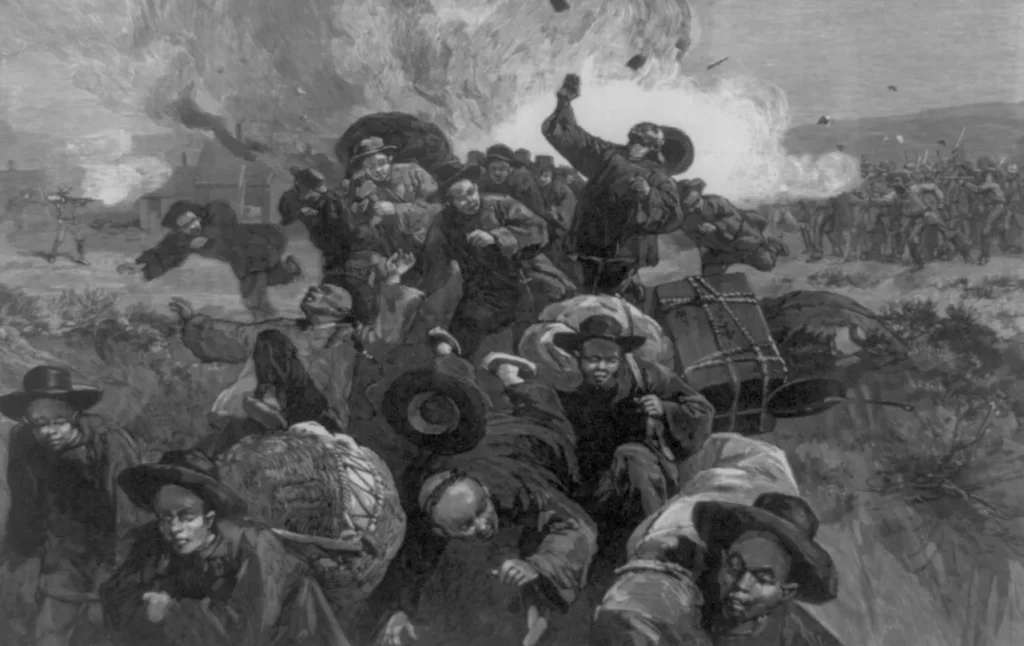Revisiting Rock Springs

The Rock Springs Massacre is one of the most horrible events in American history, a murderous pogrom that miners–mostly members of the Knights of Labor–committed against Chinese competition in the town of Rock Springs, Wyoming. The New Yorker has a very welcome discussion of an event hardly any Americans know about, as well as the archaeology going on there to try and recover what we can about Chinese life in what was always a hardscrabble town and which remains so today.
Five or six hundred people lived in the Chinese encampment. They fled in all directions. One witness later described the hills to the east of town as “literally blue with the hunted Chinamen.” Leo Qarqwang was getting treatment for his wounds when he saw armed men approaching. He ran toward the hills. He later compared Chinese residents to a flock of frightened sheep. He spent several days wandering through the sagebrush, with nothing to eat. Eventually, he found the railroad tracks and caught a train to the nearby town of Evanston. Many of the fleeing Chinese residents tumbled down the steep banks of Bitter Creek, splashing into the muddy water. At least one man was cut down as he struggled to clamber up the bank on the other side. His body was later found half submerged in the creek. Another man, Leo Mauwik, was shot in the arm as he fled. He didn’t stop running until about four o’clock in the morning, when he reached the neighboring town of Green River, about fifteen miles to the west.
Violence coursed through Rock Springs. A white woman—likely “Mrs. Osborn,” the owner of a local laundry—fired a revolver at some Chinese men as they fled, felling two of them. Another woman, by one account, had a baby in her arms but still managed to knock down a Chinese man running by. When her child wailed, she spanked him before turning to pummel the Chinese man.
The rioters began setting fire to buildings, and dense black smoke billowed over the area. Frightened residents dashed outside with blankets covering their heads. Rioters tossed bodies into the burning buildings. The smell of charred flesh was acrid. A gusting wind soon led to fears that the conflagration would spread through the town, and rioters suspended their torching of the Chinese huts, but more than forty still burned to the ground. Miners usually stored their gunpowder inside their homes. When the flames reached a cache, the sky would flash with a powerful explosion.
Ah Lee, a Chinese laundryman, had barricaded himself inside his home. Attackers broke through the roof and shot him in the back of the head. A female rioter looted bundles of laundry he had laid out for delivery. Ah Kuhn, a Chinese interpreter known for wearing a fur coat around town, took shelter in a cellar. When he emerged, several white men opened fire, and he ran in a panic, dropping about sixteen hundred dollars in gold—more than fifty thousand dollars today. He made his way to a house east of town, where a white resident gave him bread and water and allowed him to rest before he continued on his way. Several Chinese residents approached the Reverend Timothy Thirloway, who lived near Chinatown. His two daughters taught English to Chinese miners in the evenings. The fleeing residents asked if they could hide in the family’s home, but were told it would be safer if they left town. One miner, known as China Joe, hid in a large oven for three days, then sneaked out in the middle of the night and fled.
A group of rioters marched on the home of Evans, the foreman who had arrived at the No. 6 mine after the melee, and advised him to leave town. He departed that night. Next, the group visited the home of Soo Qui, one of the Chinese head men, but he was in Evanston. His terrified wife met them instead. “Soo, he go,” she said. “I go to him.” Two days later, she arrived in Evanston by train, disembarking in a colorful gown. A newspaper reporter characterized her as the “last of her race” to abandon Rock Springs and “probably the last to set foot in the place for many a long year.”
At around 7 P.M., Dave Thomas and others visited Chinatown to assess the situation. They spotted an elderly Chinese man they knew, lying in agony in the dirt. They debated whether to end his suffering by shooting him, but left him to die. The local sheriff deployed deputies around town, but struggled to muster enough men to hunt down the rioters. Throughout the night, gunfire continued, and rioters recrossed the creek to torch the remaining buildings in the Chinese quarter. The fires burned all night, bathing the town in a red glow.
I believe this is some of that DEI we keep hearing about.


